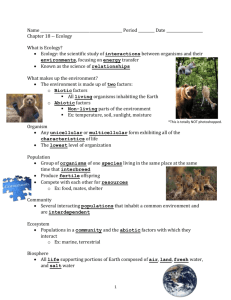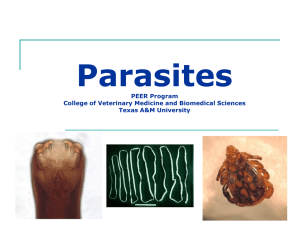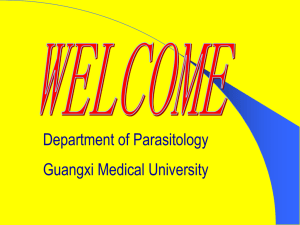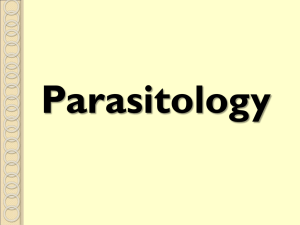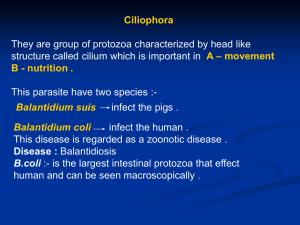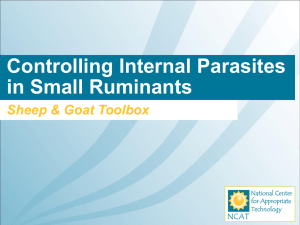Glossary - Deans Community High School
advertisement
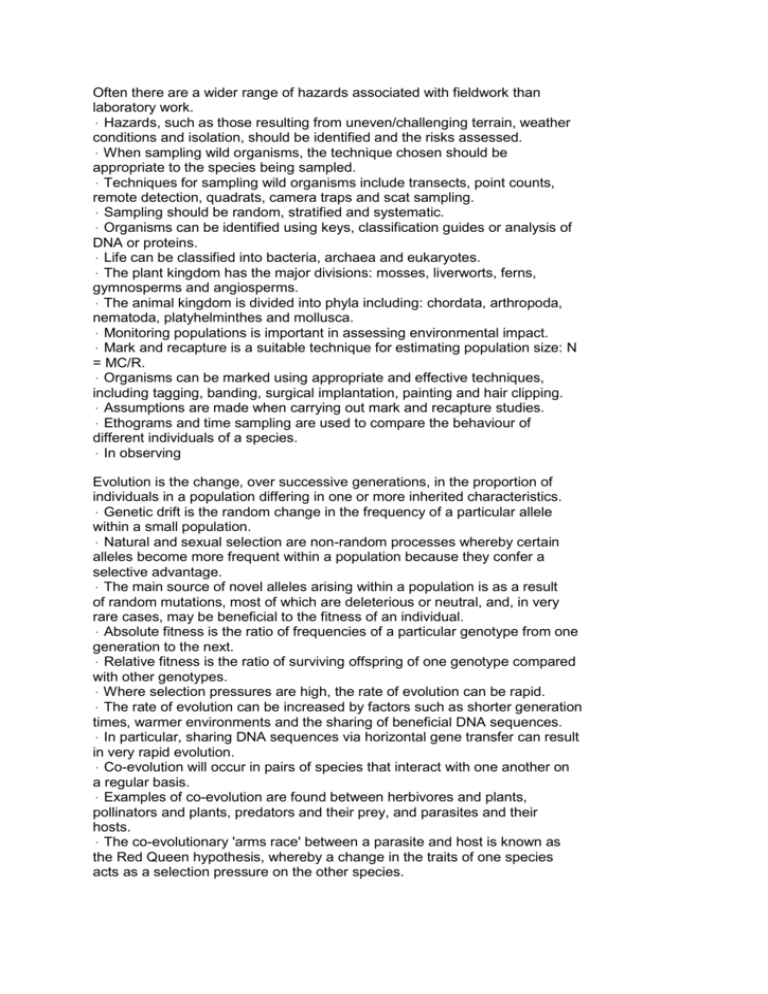
Often there are a wider range of hazards associated with fieldwork than laboratory work. • Hazards, such as those resulting from uneven/challenging terrain, weather conditions and isolation, should be identified and the risks assessed. • When sampling wild organisms, the technique chosen should be appropriate to the species being sampled. • Techniques for sampling wild organisms include transects, point counts, remote detection, quadrats, camera traps and scat sampling. • Sampling should be random, stratified and systematic. • Organisms can be identified using keys, classification guides or analysis of DNA or proteins. • Life can be classified into bacteria, archaea and eukaryotes. • The plant kingdom has the major divisions: mosses, liverworts, ferns, gymnosperms and angiosperms. • The animal kingdom is divided into phyla including: chordata, arthropoda, nematoda, platyhelminthes and mollusca. • Monitoring populations is important in assessing environmental impact. • Mark and recapture is a suitable technique for estimating population size: N = MC/R. • Organisms can be marked using appropriate and effective techniques, including tagging, banding, surgical implantation, painting and hair clipping. • Assumptions are made when carrying out mark and recapture studies. • Ethograms and time sampling are used to compare the behaviour of different individuals of a species. • In observing Evolution is the change, over successive generations, in the proportion of individuals in a population differing in one or more inherited characteristics. • Genetic drift is the random change in the frequency of a particular allele within a small population. • Natural and sexual selection are non-random processes whereby certain alleles become more frequent within a population because they confer a selective advantage. • The main source of novel alleles arising within a population is as a result of random mutations, most of which are deleterious or neutral, and, in very rare cases, may be beneficial to the fitness of an individual. • Absolute fitness is the ratio of frequencies of a particular genotype from one generation to the next. • Relative fitness is the ratio of surviving offspring of one genotype compared with other genotypes. • Where selection pressures are high, the rate of evolution can be rapid. • The rate of evolution can be increased by factors such as shorter generation times, warmer environments and the sharing of beneficial DNA sequences. • In particular, sharing DNA sequences via horizontal gene transfer can result in very rapid evolution. • Co-evolution will occur in pairs of species that interact with one another on a regular basis. • Examples of co-evolution are found between herbivores and plants, pollinators and plants, predators and their prey, and parasites and their hosts. • The co-evolutionary 'arms race' between a parasite and host is known as the Red Queen hypothesis, whereby a change in the traits of one species acts as a selection pressure on the other species. There are two disadvantages of sexual reproduction. Only females can produce offspring and each parent only passes on 50% of their genes rather than the full 100%. • The one advantage of sexual reproduction is the huge genetic variability amongst offspring, which outweighs any disadvantages. • Asexual reproduction is ideal in stable niches and includes strategies in eukaryotes, such as vegetative propagation in plants and parthenogenesis in some insects and reptiles • For prokaryotes, where reproduction tends to be asexual, horizontal gene transfer between individuals is a common mechanism. • Meiosis is the process whereby one diploid gamete mother cell divides into four genetically dissimilar haploid gametes. • Independent assortment and crossing over both occur in meiosis I and are responsible for increasing the genetic variation amongst gametes. • Homologous chromosomes are pairs of chromosomes of the same size, with the same centromere position and with the same genes at the same loci. • The alleles of the genes on homologous chromosomes may, however, be dissimilar because each homologous chromosome is inherited from a different parent. • Linked genes are found on the same chromosome. The frequency of linked chromosomes being separated through crossing over can be used to map chromosomes. • Hermaphrodites are organisms with both male and female reproductive organs. • In some organisms, such as crocodiles, environmental conditions can affect the sex ratio of offspring. • In other cases, the sex ratio is related to resource availability. • Some organisms can change their sex in their lifetime depending on environmental conditions, parasitic infection or competition. • In mammals, males tend to be heterogametic. This means that sex linked traits are more common in males than females. • Females can be carriers of a recessive sex-linked trait, yet show no deleterious effects. The reason for this is that one X chromosome in each cell is randomly deactivated so that half of the cells will contain an active working copy of the gene. Egg production, with their energy store and larger size, involves a far greater energy investment than sperm production, meaning that females have a greater sexual investment. • Sessile organisms use asexual reproduction, hermaphroditism, mass release of gametes and very long penises, as appropriate, to increase their reproductive success. • Organisms will employ the most successful reproductive strategy possible, assessing the number and quality of current offspring against the potential for future offspring. • Organisms can be classed as r-selected or K-selected organisms based on their reproductive strategy and life history, although organisms can display traits of both groups. • Sexual dimorphism is when males and females of the same species have very different physical appearance, often in terms of colour and size - this is a result of sexual selection. • Females are usually inconspicuous. • Sexual dimorphism can be reversed in some species. • Male-male rivalry sees larger males, often with appendages used a weapons, having greater success at finding a mate. • Smaller males may employ sneaking behaviour and see equal success at gaining access to females. • Successful courtship is often the result of species-specific sign stimuli that bring about a fixed action pattern response. • Imprinting is an irreversible process in young birds where they fixate on a larger living thing for protection and nurturing; this may affect mate choice later in life. • Lekking is when males of a species, usually birds, gather in a display area called a lek; females attend the lek and choose a mate. • Females assess male fitness, basing it on 'honest' signals such a low parasite burden and good condition. Parasites have a narrow niche due to high host specificity. • Parasites are said to be degenerate due to the absence of certain structures and organs. • Ectoparasites live on the surface of their host, whereas endoparasites live inside their host. • The definitive or primary host is the host where the parasite reaches sexual maturity. • In the case of indirect life cycles, some parasites also have a secondary or intermediate host that is used in transmission or where an asexual phase of their life cycle may occur. • Indirect life cycles are highly evolved and greatly increase parasite success. • Vectors, such as insects, or water transmit parasites. • The fundamental niche is the parasite's niche in the absence of interspecific competition. • The realised niche is the parasite's niche in the present of interspecific competition. • When interspecific competition occurs between species with very similar niches, usually one of the two species becomes locally extinct. • If the two species can compromise over resources by means of resource partitioning, both may co-exist. • Higher rates of parasite transmission are linked to higher virulence. • Transmission can be increased in overcrowded regions and where vectors are available. Parasites are said to modify host behaviour to increase transmission by altering host foraging behaviour, anti-predator behaviour, sexual behaviour, movement and habitat choice. • These modifications are said to be an extension of the parasite's phenotype in a theory known as "The Extended Phenotype". • Parasites also suppress host immune responses, and modify host size and reproduction for their own benefit. Mammals are armed with non-specific defences to parasite attack. The skin provides a physical barrier, and mucus, saliva, tears and stomach acid all provide chemical barriers. • Inflammatory response is a non-specific defences that increases the blood flow to an injured area. • Phagocytes provide non-specific defence by engulfing foreign antigens into a vacuole. Special organelles called lysosomes then fuse with the vacuole releasing digestive enzymes to digest the antigen. • Natural killer cells are white blood cells that destroy abnormal cells by bringing about apoptosis. • Phagocytes also have a role in specific defence, by presenting foreign antigens to lymphocytes. • Specific lymphocytes are produced in response to specific antigens. • B lymphocytes produce specific antibodies to combat specific foreign antigens. • T lymphocytes target infected or damaged cells and bring about apoptosis. • Lymphocytes are amplified through mitosis. This is called clonal selection. Some clones are used in combating the attack. Others become immunological memory cells. • Endoparasites are able to mimic host antigens and avoid destruction. • Many parasites show vast antigenic variation. This means being immune to one strain does not confer immunity to other strains. • Epidemiology is the study of outbreak and spread of infection diseases. • Herd immunity is the protection offered to susceptible individuals by resistant individuals within the population. • The herd immunity threshold is the density of resistant hosts in the population required to prevent an epidemic. Common parasites include protists, platyhelminthes, nematodes, ectoparasitic arthropods, bacteria and viruses. • Ectoparasites are transmitted via direct contact. • Endoparasites of the body cavities are transmitted via direct contact or consumption of secondary hosts. • Endoparasites of the body tissues are transmitted via vectors. • Schistosomiasis and malaria are examples of human diseases caused by parasites. • Plasmodium species and Schistosoma species require two hosts to complete their life cycles. • Other parasites can complete their life cycle within one host. Examples include endoparasitic amoebas and ectoparasitic ticks. • Tuberculosis is a human disease caused by bacteria while influenza and HIV are human diseases caused by viruses. • Many bacteria and viruses can complete their life cycles within a single host. • Viruses are composed of nucleic acid enclosed inside a protein coat. • The outer surface of a virus contains antigens that a host cell may or may not be able to detect as foreign. • Some viruses are further surrounded by a lipid membrane, composed of the host's materials. • The lipid surround is thought to aid the virus in remaining undetected inside the host cell. • Retroviruses are viruses that contain RNA as their genetic material rather than DNA. HIV is an example of a retrovirus. • RNA retroviruses use the enzyme reverse transcriptase to first produce DNA, which is then inserted into the genome of the host cell. These virus genes form new viral particles when transcribed inside the host. Glossary Absolute fitness the ratio of frequencies of a particular genotype from one generation to the next Amoeba a single-celled parasite Angiosperms flowering plants Anthropomorphism crediting animal behaviour with human emotions or qualities Antigen a protein that may induce an immune response if it is foreign Antigenic variation where parasites show great variety amongst different strains Apoptosis cell death Arthropoda joint-legged invertebrates which are identified by their segmented body, typically with paired appendages, e.g. wasps, butterflies, spiders, and crabs Autosome any chromosome that is not a sex chromosome Bacteriophage a virus that targets a bacterial host B lymphocytes white blood cells that produce specific antibodies in response to specific antigens Chiasmata the place where two homologous chromosomes come into contact with one another Chordata sea squirts and vertebrates, e.g. birds, mammals, reptiles, amphibians and fish Civil engineering a profession that is involved in the design and manufacture of infrastructure to improve standards of living Clonal selection lymphocytes become amplified, with some clones used in immediate defence and other clones acting as memory cells © HERIOT-W ATT UNIVERSITY 136 GLOSSARY Co-evolution where a change in the traits of one species acts as a selection pressure on another species with which it frequently interacts Competitive exclusion principle when two species are in intense competition with one another and the weaker of the two species becomes locally extinct Crossing over the process where homologous chromosomes swap genetic material Cysticercosis a parasitic tissue infection Definitive (primary) host the host where the parasite reaches sexual maturity Ectoparasite a parasite that lives on the surface of the host, e.g. ticks Endoparasite a parasite that lives inside the host, e.g. tapeworms and flatworms Epidemiology the study of the outbreak and spread of infectious diseases Ethogram chart on which observed animal behaviour is recorded Ethology study of animal behaviour Evolution the change, over successive generations, in the proportion of individuals in a population differing in one or more inherited traits Extended phenotype a theory whereby the parasite modifies the host's behaviour to increase its own transmission Ferns flowerless plants that reproduce by producing spores and which have a vascular system Fundamental niche the niche that an organism occupies when there are no other species present competing for space or resources Genetic drift the random change in how frequently a particular allele occurs within a small population © HERIOT-W ATT UNIVERSITY GLOSSARY 137 Gravid proglottid the segment of a tapeworm containing both male and female reproductive organs Gymnosperms flowerless vascular plants that produce seeds for reproduction, e.g. the conifer Herd immunity protection offered to non-immune members of a population by sufficient numbers immune individuals Herd immunity threshold the density of resistant hosts in the population required to prevent an epidemic Hermaphrodite an organism with both male and female reproductive organs Heterogametic dissimilar sex chromosomes, e.g. mammalian males where the Y chromosome is much smaller than the X chromosome Homologous chromosomes chromosomes of the same size, same centromere position and which carry the same genes at the same gene loci Immune surveillance white blood cells patrol the body, recognising and destroying foreign pathogens Imprinting an irreversible process that occurs within a critical period of young bird development - it can have an impact on mate choice later in life Independent assortment takes place during meiosis I when homologous chromosomes pair up and line up along the equator - the final position of one pair is completely random relative to every other pair Inflammatory response injured or wounded areas become warm and red due to increased blood flow, bringing white cells for defence Intermediate (secondary) host the host that the parasite might require in order to complete its life cycle or as a means of transmission, thus making it a vector Interphase takes place at the start of meiosis when DNA replication occurs K-selected larger organisms that usually produce lower numbers of offspring, providing more extensive parental care and have longer life spans © HERIOT-W ATT UNIVERSITY 138 GLOSSARY Lekking males display for females in a communal display area, then females choose a mate Line transect line along which quadrats are placed or samples taken Linked genes genes that are on the same chromosome Liverworts flowerless, spore producing plants with flattened stems and overlapping leaves Lysis the bursting of a host cell, releasing many virus particles Malaria a serious human disease spread by mosquitoes that are infected with the malaria parasite Meiosis a special type of cell division where four haploid gametes are produced from one diploid gamete mother cell Memory cells cloned lymphocytes that remain in the body to respond faster if the individual is exposed to the same antigen a second time Mollusca molluscs which are greatly varied, with many characterised by the presence of a shell, e.g. snails and octopi Monogamy where animals form breeding pairs, thus one male to one female Mosses flowerless plants, lacking seeds and a vascular system Mutation random change in DNA sequences within a population Mutualism symbiotic relationship where both species benefit Natural killer cells lymphocytes responsible for destroying abnormal cells Natural selection non-random process whereby certain alleles occur more frequently within a population because they confer a selective advantage © HERIOT-W ATT UNIVERSITY GLOSSARY 139 Nematoda round worms. which show great variety, many of which are parasitic, e.g. tapeworms Parasite an organism that gains food and shelter at the expense of the host Parthenogenesis asexual reproduction whereby embryos develop from an unfertilised egg Phagocyte white blood cell in non-specific defence, engulfing and destroying foreign antigens -may also present antigens to lymphocytes Phagocytosis non-specific defence where phagocytes engulf foreign antigens and digest them using digestive enzymes present in lysosomes Platyhelminthes flatworms which show bilateral symmetry with internal organs present, but which lack a body cavity, many of which are parasitic Point count sampling techniques used for birds Pollinator an organism that transfers pollen from the anther of one flower to the stigma of usually another flower, e.g. bee or hummingbird Polygamy usually where one male has access to mate with several females Random sampling individuals selected from the larger population must be chosen completely by chance Realised niche the niche that an organism occupies when there is competition from other species Recombinant the chromosome created when linked genes are separated during crossing over Red Queen hypothesis a theory concerning co-evolution of a parasite and its host Relative fitness the ratio of surviving offspring of one genotype compared with other genotypes Resource partitioning where two species occupy different realised niches, allowing them to co-exist by compromising over resources © HERIOT-W ATT UNIVERSITY 140 GLOSSARY Retrotransposon the piece of DNA that carries out reverse transcription before being inserted into a new site on the genome Retrovirus a virus that contains RNA as its nucleic acid Reverse transcriptase an enzyme used by retroviruses to synthesise DNA that can be inserted into the host cell's genome r-selected smaller organisms that usually produce larger numbers of offspring, providing no parental care and having shorter life spans Sanitation access to facilities for safely disposing of human waste such as urine and faeces Satellite male male that sneaks to gain access to females Schistosomiasis also known as bilharzias, a human disease caused by parasites living in fresh water in sub-tropical and tropical regions of the world Sessile organism that is fixed in position - cannot move Sexual dimorphism physical difference between males and females of a species Sexual selection a non-random process, whereby certain alleles occur more frequently within a population because they are selected/preferred by one sex Sneaker male that gains access to mate with females without the more dominant male knowing Stratified sampling individuals are randomly selected from sub-groups within a population Symbiosis an interrelationship between organisms of two different species, whereby at least one species benefits Systematic sampling where samples may be taken at regular/pre-set intervals, e.g. every 2m along the transect © HERIOT-W ATT UNIVERSITY GLOSSARY 141 Taxonomy grouping living organisms based on similarities or relatedness Terrain the physical geography of the land T lymphocytes lymphocytes that destroy specific infected or damaged cells by bringing about apoptosis Transmission the spread of a parasite to a host Vector the means of transmitting a parasite Vegetative propagation/cloning a form of asexual reproduction that takes place in some plants, resulting in offspring that are genetically identical to the parent plant, e.g. bulbs and runners Virulence the deleterious effect that the parasite has on the host Waterborne transmitted by water © HERIOT-

